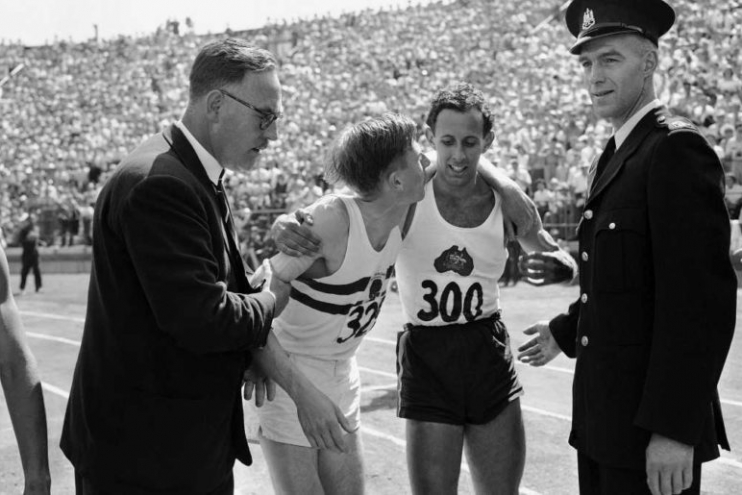Bannister of Britain vs Landy of Australia was track’s version of the first Ali vs Frazier fight
Historian David Tarbotton revisits the August 7, 1954 Mile of the Century
#OnThisDay 7 August 1954, one of the greatest races in the history of athletics was held at the Vancouver British Empire and Commonwealth Games. The race between England’s Roger Bannister and Australia’s John Landy was dubbed the Miracle Mile or Mile of the Century. Speaking yesterday from his country Victorian home, John Landy, recalled the race which captured world-wide interest 63-years ago.
THE LEAD UP
“There was tremendous interest from the American press although their country were not members of the Commonwealth. Sports Illustrated featured an article in their first published edition of our race,” Landy recalled yesterday.
Athletics was at the right place at the right time when Sports Illustrated commenced publication with their first edition on 16 August 1954. Legendary US Sportsmen Joe DiMaggio, Joe Louis, Sammy Baugh and Bob Mathias were recently retired and the world was focused on the race to the first sub-four mile. That historic moment was followed by a match race.
Sports Illustrated recently reflected what they were featuring in their first year of publication.
“In 1954 all sports stories were overshadowed by what happened on that track in England on May 6. For years breaking four minutes in the mile run had been the most elusive of athletic barriers. The world record had been lowered gradually with Sweden’s Gunder Hagg running 4:01.4 in 1945. Six weeks later, John Landy of Australia lowered Bannister’s record to 3:58 setting up what was called “The Miracle Mile” at the British Empire Games in Vancouver, British Columbia, on Aug. 7. Bannister of Britain vs. Landy of Australia was track’s version of the first Ali vs. Frazier fight in 1971 with millions around the world trying to follow the race on the western edge of the North American continent.”
The scene was set for the first ever clash of John Landy and Roger Bannister at the in Vancouver. Times were important, but a race would surely determine who really was the best athlete. The world was demanding it. Bannister even noted this in his autobiography:
“The four-minute mile, however final and perfect it had seemed at Oxford, now meant nothing unless I could defeat John Landy.”
Upon arrival in Vancouver, Bannister was happy to be second favourite. However, he had strong motivation – the disappointment of the 1500m at the 1952 Olympic Games, where he was favourite but placed fourth. However, he was also battling a cold in Vancouver.
Landy was in trouble too. Unknown to many, the night before the race, he was unable to sleep and stepped outside his hut in the Games village only to tread on a discarded flash bulb. The result was a cut about four centimetres long and quite deep in his left instep. In the morning four stitches were inserted. Speaking yesterday, Landy downplayed this incident.
“It had no effect. I ran on the ball of my foot and the cut was on the instep.”
Although he did admit there were clear after effects of a cut.
“When I took my sock off (following the race) there was blood everywhere.”
THE RACE
An anticipating crowd of 35,000 packed into the Empire Stadium. All over the American continent 100 million television viewers turn intently to their sets and thousands of miles away in Australia, radios were switched on. There was a hush across the stadium before the gun fired unleashing one mighty continuous roar from the crowd. From the start Landy was straight into the lead, passing the first lap in 58.2 seconds with Bannister sitting in second. But Landy continued to stretch his lead to 15 metres at the mid-way point reached in 1:58.1 minutes. Landy’s tactics had suited Bannister who had preferred to sit and kick, but he needed to be closer at the bell. On the third lap, Bannister did narrow the gap, to about three metres as Landy passed the bell in 2:58 minutes. With 300 metres to go Landy surged, but unbeknown to him he couldn’t shake off the Englishman. As they entered the straight, with just 100 metres remaining, Landy glanced to his left.
“I looked back expecting to see him 10 metres behind. I had run out of steam and was not able to keep the pace up in the home straight,” said Landy yesterday.
Bannister seizes the opportunity and moved past Landy on his outside, and with the momentum in his favour strode to the line a winner. Bannister clocked a personal best 3:58.8, with Landy second in 3:59.6.
Landy reflected on his front running plan for the race.
“I had no experience running tactical races. The strategy was high-risk but I knew it would make it a great race.”
That was Bannister’s last ever mile, retiring at the end of the season and being named Sports Illustrated’s first “Sportsman of the Year.” Landy also considered retirement at the end of the year to pursue his teaching career, but after a short break, he did return to win a bronze medal in the 1500m at the Melbourne 1956 Olympics.
The two remain good friends and in regular contact. “We exchange Christmas cards and letters,” Landy noted.

